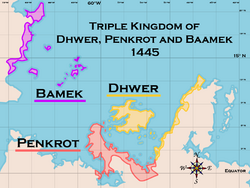Triple Kingdom of Dhwer, Penkrot and Bamek
| Triple Kingdom of Dhwer, Penkrot and Bamek | |||||
| |||||
Maximum territorial extent of the Triple Kingdom
| |||||
| Capital | KeHarl | ||||
| Languages | Dhweran, Penkrotian, Mbamigi | ||||
| Religion | Kuyanism, Thentism, Mbamegumi | ||||
| Political structure | State union | ||||
| History | |||||
| • | Parmaw Revolt | May 9th 1215 | |||
| • | De facto maximum extent | 1445 | |||
| • | De facto dissolution | 1506 | |||
| • | Start of the Quonco-Dhweran War | 1782 | |||
| • | Setyal conquest of Penkrot | 1780s | |||
| • | Declaration of the UKDP | 1812 | |||
| • | Mbamigi Independence | 1922 | |||
| b. | ... | ||||
The Triple Kingdom was the heir to the Great Dhweran Empire and the premiere Dhweran polity through the late middle ages and gunpowder era. The constituent kingdoms, and particularly their navies, enjoyed a great deal of autonomy throughout this period and the Triple Kingdom was relegated to a legal fiction for around three centuries of its existence and this historical period is often named the "Small Kings Period" in Dhweran historiography.
History
The Triple Kingdom rose from the ashes of the Great Dhweran Empire after the Parmaw Revolt of 1215. While much of the territory of the GDE fell out of Dhweran hands following the rebellion, the Triple Kingdom managed to retain, except for Thewer, its most economically, culturally and militarily important centers. The Triple Kingdom was, at this period already, a highly decentralized affair, with real power staying not in the hands of the constituent Kings, and much less of a king over the others, but in the hands of whichever admiral controlled the largest fleet, both kingdom internally and for the union as a whole. In the fourteenth and fifteenth centuries this process of militarization and fragmentation would only accelerate, as the introduction of gunpowder and canons, coupled with the naval arms race waged against Bavkir polities would make navies and admirals even more important to the overall functioning of the region. This was also, however, a period of expansion, with Bamek conquering a sizeable chunk of Naguan coast, Penkrot retaking Yaageqyë from Kav polities and Dhwer proper reconquering most of the western Hayledarep coast, culminating in the 1445 maximum extent displayed on the map to the right.
The naval arms race against the Bavkir was ultimately lost and the following centuries would be characterized by a downwards trajectory. In the 16th century Dhwer suffered some major defeats to Haraku and to the Second Bavkir Empire and after the weakening of its navy, the largest in the Triple Kingdom, the other two kingdoms became effectively independent, even if the union was never formally disbanded. This independence did not mean the kingdoms would individually flourish. Bamek slowly lost control of the naguan coast, first to native ambaroid polities and later decisively relinquished control of them in the Quonco-Dhweran War in the late 18th century, which marked another decisive defeat for the Triple Kingdom naval fleet. Penkrot enjoyed a period of relative stability in the 16th and 17th centuries, sometimes called the Small Silver Age, which came to a decisive end with the rise of the Setyal Empire in the early 1700s. The Setyal campaign in the Yaa Peninsula conquered most Penkrotian land and culminated in the Kadhgaw Siege which lasted through the 1780s. Penkrotian nobility fled to the island of Dhwer and was slowly absorbed into Dhweran nobility, resulting in the Union of the Dhweran and Penkrotian crowns in 1812.
The expansion of the Setyal Empire and the constant conflicts with it through the 1700s and early 1800s bolstered a newfound sense of Dhweran Nationalism and started efforts to bring together the territories of the Triple Kingdom under a single, absolute, monarch. After the Union of the Crowns in 1812 and with a weakened Bamek, a new Kingdom was declared, the United Kingdom of Dhwer and Penkrot. Mbamigi natives, having enjoyed de facto independence through most of the Triple Kingdom period, were not embroiled in Dhweran Nationalism or particularly invested in the legal fiction of the Triple Kingdom and immediately initiated armed resistance and independence movements from the UKDP, eventually succeeding after a non-violent resistance movement gained international support.

